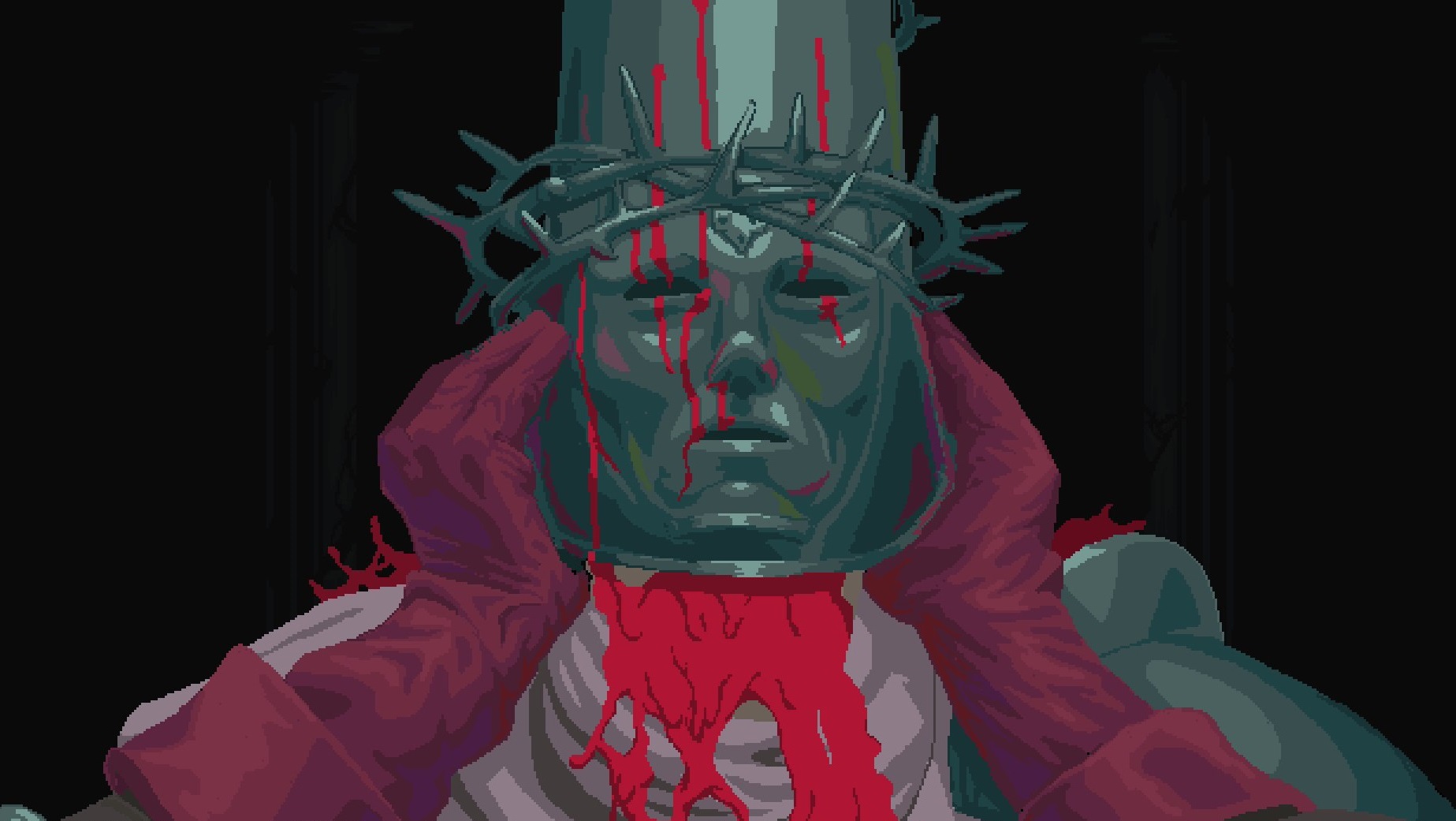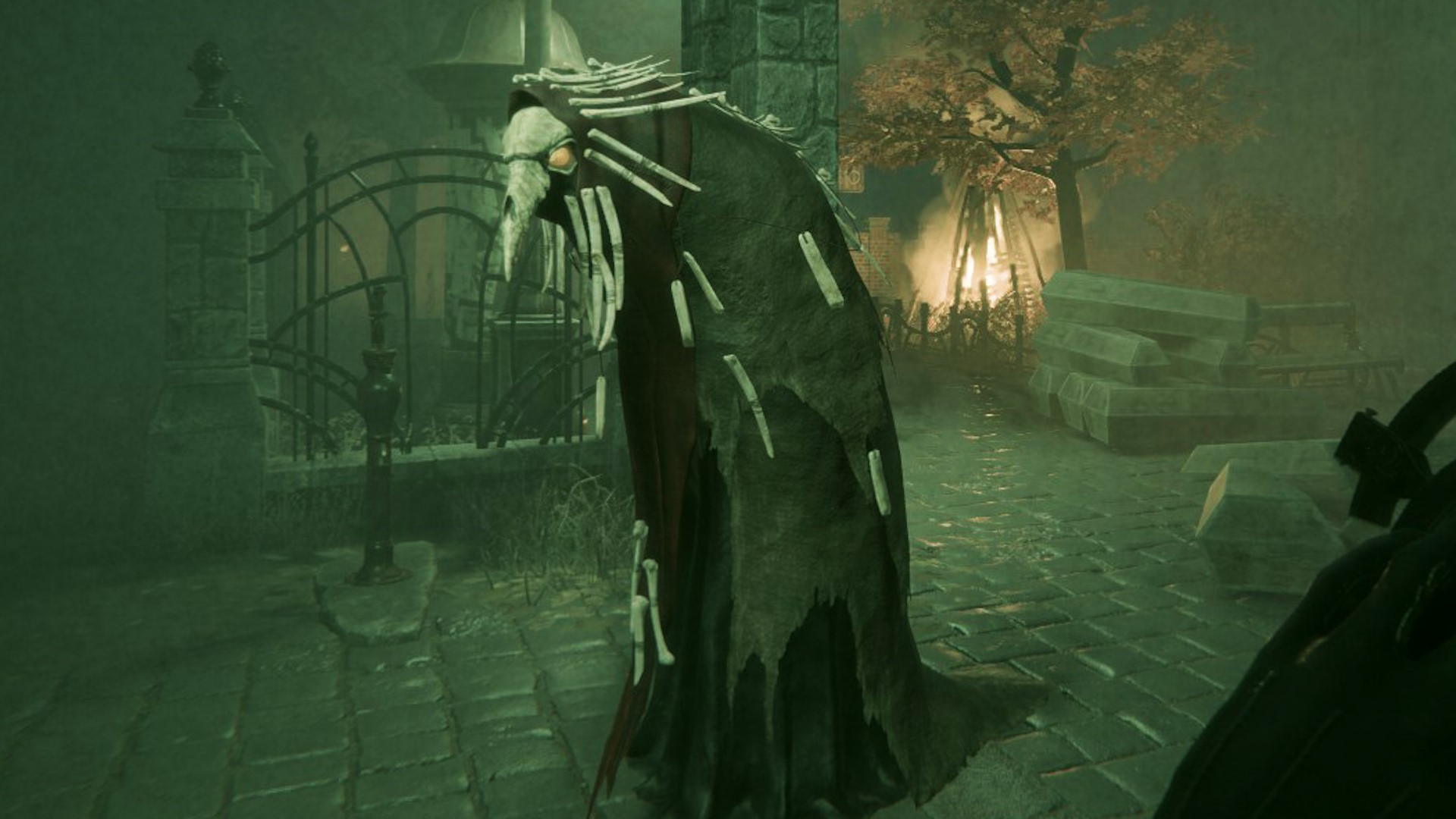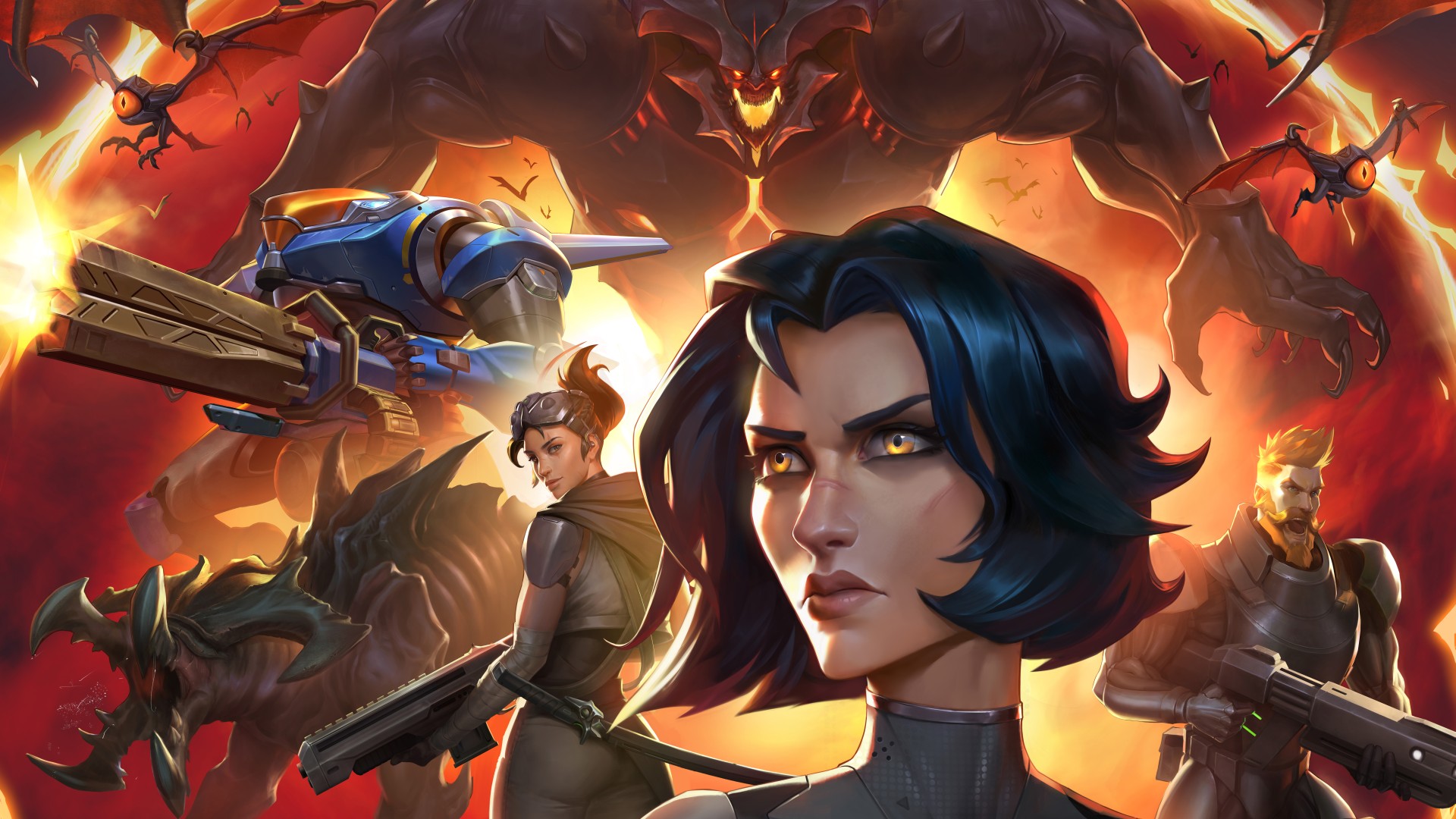
Orcs Must Die! Deathtrap Review

It occurs to me that the Orcs Must Die! series – and the tower-defense genre as a whole – are something like a cousin to factory games like Satisfactory and Factorio. Those games focus on feeding raw resources like iron and coal into complex machines to efficiently produce spaceship parts, while Orcs Must Die! is about feeding hordes of cartoon monsters into machines that produce… mulched cartoon monsters. Maybe one day we’ll learn to build spaceships out of that goop, but for now just creating it is plenty of fun on its own.
Deathtrap, the fifth OMD game (if you count the now-defunct Unchained), shifts its reliable action-tower defense gameplay into a new structure: rather than a linear series of levels to figure out one at a time, we’re put through a roguelite-style gauntlet of randomly selected stages, each with a mix of modifiers that can make both you and the orcs more powerful in sometimes interesting ways, capped off by a boss fight. Burning through those can be a blast, especially with up to three friends in the new co-op cap of four, but like a lot of run-based games it does eventually get a little too grindy (and not the kind where you’re grinding up orcs) and repetitious for its own good.
I say that in part because after more than 60 hours playing Deathtrap in both co-op and single-player, I’ve only seen three of its four bosses and defeated two. While it’s generally IGN’s policy to complete a game’s content before writing a review (and if we don’t, we’ll tell you and explain why), this is one of the rare cases where it’s become clear that it’s meant to take a very long time to check all the boxes, and also that I’ve already seen the great majority of what’s here. Over the course of dozens of runs I’ve unlocked every trap, played all six characters, and seen all but probably the final boss and his map. I’ve also not yet seen a potential ending story cutscene, but considering Deathtrap is even lighter on storytelling than Orcs Must Die! has traditionally been, I think I can safely tie a bow on this review without grinding out the rest of the skill tree and unlocking the character skin set that’s on display for 99,999 skulls (AKA in-game money).
Setting out on your first run is as easy as picking a character and diving in, which is a no-brainer because one of the options is Sophie, an anthropomorphic cat with curved swords and throwing stars who summons a skeleton warrior buddy and lays bear traps. Of course that’s your first choice for a third-person action game like this, unless you’re playing co-op and someone else gets to her first. In that case it’s understandable that you’d fall back on an old-school OMD archetype like Vaan, who wields a crossbow (that’s actually a machine gun for all intents and purposes) and can temporarily prevent the rift you’re protecting from taking any damage from orcs. After cycling through them all, including tanky bear-man Kalos, Riftkin sniper Mac, and Harlow, the blunderbuss lady with a pet dragon, I settled on Wren the mage as my favorite: her rifle-like wand includes an active reload minigame for bonuses, she summons floating proximity mines, recharges traps for quicker kills, and conjures two clones of herself to attack in triplicate. It’s a strong cast as a whole, though, and while there’s not much by way of a plot beyond “kill the orcs” for them to act out, they all have distinct personalities that come through in their various jokey combat shouts.
Immediately thereafter you’re presented with a choice of three levels to tackle, but this comes with a catch that complicates it and – for me – almost always overrides my preference for one map over another: each is randomly assigned a modifier that ranges from increasing orc damage by 25% to a specific special enemy type being guaranteed to show up every time, or maybe you’ll always see an unstable rift appear that must be quickly destroyed before it spews out even more enemies. These modifiers carry extra weight because they don’t just affect that one map, but all of the rest going forward on this run, and the tough ones can put a fear in me. If I’m playing as a sniper, I definitely do not want the one that reduces headshot damage by 50% (because zoomed-in headshots are my whole thing!) – and when you’re playing in co-op you have to make a group call that screws you all over the least.
That’s not to say the choice of map isn’t important. They’re mostly fairly large – bigger than what’s been standard for the series, but smaller than Orcs Must Die! 3’s War Scenarios – and after playing each one what feels like a dozen times or more, I’ve definitely developed favorites for those where I know how to control the orcs’ paths and eye-rolling dislikes for those that are more wide open and almost impossible to fully wrangle unless you’ve lucked into certain upgrades. As long as the randomized modifier price isn’t too high I’ll go for one where I know I can force incoming waves into a narrow path of movement-slowing tar traps lined by threshing machines on the walls and lasers, acid, or poison raining down from above, all while auto-targeting turrets knock down annoying flying enemies before they can slip by my barricades. Those feel like guaranteed wins.
It’s worth noting that while Deathtrap’s orcs and maps look very much like the previous OMD games because of its cartoony art style, the lighting is notably improved, and that’s something that’s on full display when the nighttime and rain modifiers are in effect. Those aren’t just for looks and come with randomly spawning skeleton orcs and water elementals, respectively, that can spring into existence behind your barricade lines. That’s a good way to keep us on our toes when we’re feeling like we’ve got things locked down – you’ve always got to keep an eye on the minimap when you hear the telltale sound effects and warning calls.
If I must, though, I’ll choose a stage like the Dry Docks map: a shipyard where the rift can be in one of several locations and there are more paths to each of them than the default number of barricades can block off. The opening phase of any Orcs Must Die! map, and the unlimited-length pauses between waves, are spent figuring out the puzzle of how to control the coming flow of enemies. They will usually approach from four different doors that gradually open up, and the idea is to send them on the longest routes that overlap as much as possible, creating killzones where your traps will provide the most bang for your buck. Efficiently obstructing paths is tricky, but the ghostly previews showing where orcs are able to run based on the options available to them help to spot and plug holes. There are almost never enough barricades to go around, so you’ll often have to make the best of a bad situation and decide what holes you’re going to have to fill with your own magical bullets.
“Why not simply buy more barricades?” OMD veterans may ask. Well, Deathtrap revamps the way barricades are handled in a fairly radical way: rather than being a trap item you can buy for increasing amounts of cash, your team gets a set number that can be placed for free (and are replaced between waves if they’re destroyed). Overall I like this change because it’s an acknowledgement of how crucial it is to block off portions of the map, but it also serves as the number one way I know if a run is going to go well or not. If I don’t luck into at least a few more via the random upgrades you pick from at the end of each round (or better yet, the upgrade that makes the barricades I have twice as large) I’m probably gonna have a rough time when the going gets tough.
Boosting the number or shape of your barricades is far from a sure thing, though, because even though each player gets to pick a new upgrade card from a set of three randomized options at the end of every wave – six per level and a bonus at the end – there are so many of these “thread” cards in the mix, especially as you unlock more and more with in-game achievements, that it’s easy to wind up with everything but.
My other issue with how barricades are handled is that, when you’re playing in co-op, the team’s supply is evenly divided between you and your teammates. It sounds fair, but it’s often annoying when you’re the person with the plan but have to stop halfway through executing it to call over whoever has barricades left and instruct them on where to place them. Also, if a barricade breaks during combat, the most barricade-minded person is going to be the one who’s completely out and has to call someone else to rush over and plug the hole. So while it makes sense to have traps and cash divided between teammates because it encourages you to use each of your inventory slots wisely and synergize which death dealers work well together, I feel like barricades would’ve been much better off as a shared pool.
To be fair, some of those other thread cards can be quite powerful, so not all is lost if you don’t draw barricades. They could lend your default attacks major bonuses to ammo capacity, give them burn, freeze, or shock damage, or provide extra uses of special abilities, among many other things. Wren, for example, can have four proximity mines out at a time by default, but I’ve raised that as high as seven. One card makes you shoot extra-large projectiles for some reason (they don’t do more damage, they’re just big). But none I’ve seen matches the impact of having more barricades, which makes even the Cursed card that grants 10 additional blocks but makes all your traps cost 10 times more potentially worthwhile if you’re on a team of three or four (their traps aren’t affected).
Which traps you put where is the other big part of the puzzle, and since you can only carry a handful of them with you (especially in co-op) for each level, you have to carefully examine the map layout to see where you can place the best combos of floor, wall, and ceiling traps to both deal damage and rack up scoring combos with multiple types of damage on single targets (which charge up your most powerful abilities). There are a few dozen of these, the vast majority of which are old stalwarts like the Brimstone floor tiles that set enemies ablaze, flippers that launch them into the sea, arrow walls right out of Indiana Jones, saw traps, freeze traps, acid traps, poison traps, you name it. A few new ones round out the arsenal, such as the harpoon that snags enemies to pull them in and a heavy ice turret – I’ll be interested to see how the creative types out there combine all of these.
Enemy variety is also largely recycled from Orcs Must Die! 3’s dozens of trolls, ogres, elementals, flying guys, and hunters who ignore traps and barricades to chase down Warmages, but it does build at least a bit on what came before with around a dozen or so new types. The Stonebat, for example, petrifies you with a projectile that takes you out of the action for several seconds and can be extremely annoying if you don’t take them out, and there’s an orc suspended by a balloon that seems functionally similar to the various bats but takes a few more hits. There’s also a big floating cyclops who sails over traps and then blasts you with a damage-hose laser beam from his eye if you stand between him and the rift, a drummer who doesn’t attack but buffs other orcs, shielded ogres, troll archers, and a lizardman thief who hunts you down and steals your coins, among others. All in all it’s a more than healthy mix that keeps things interesting for a long while.
At the end of each map you’re given the option to cash out with the money you’ve made thus far or wager half of it on whether or not you’ll be able to beat the next map before enough orcs make it to your rift, which has a persistent “health.” It’s a smart mechanic because sometimes you’ll just barely eke out a win with one or two rift points remaining and have to make a call about whether to go on or go home and level up, and I much prefer this to feeling like I had to beat every level of previous OMD games without a single orc making it through my defenses to really feel like I’d beaten it.
If you make it to the boss fights, Deathtrap at least makes an effort to change up its style: there’s only one large wave to deal with and you get a big chunk of change to spend, but there’s an extra powerful enemy walking or teleporting around the map while you do it. So you can go all-in on inflicting as much damage on them as possible or try to hold out until you exhaust the wave of enemies before turning your attention to the main target. But in my experience, the boss fights don’t turn any major ideas on their heads.
Win or lose, you’ll return to your fortress and use your cash to buy permanent upgrades that are sometimes meaningful, like the ones to each individual Warmage that unlock or amplify abilities or let you do +50% damage to bosses, and others that give you an almost imperceptibly incremental improvement to trap damage, speed, or other stats. Given that upgrades often get dramatically more expensive as you go, it can be a bit frustrating to spend so much for so little to improve your chances on the next run.
What eventually slowed my progress to a crawl was the fact that as you progress from one map to the next in your run, the orcs steadily get stronger and more durable rather than more numerous. In the first mission you’ll tear through waves solo, one-shotting most enemies before they can even reach your kill zone. But by the fourth, I was emptying entire 45-bolt crossbow magazines into a single heavy orc’s face and having to stop to reload before polishing him off. It gets tiring, frankly, especially when dealing with enemies with magical armor that diminish the impact of your weapons and traps even further.
Considering that each run consists of several missions, starting with three and going up by one every time you beat a boss, runs become excessively long. I’ve beaten two, so I currently have to do five missions of six waves apiece before the boss fight, and each one can take around half an hour. You can save between missions in single-player but not in co-op, so that becomes a serious time commitment if you’re playing as a team. Also, I wish there were a way to skip the first one or two missions, which are effectively a foregone conclusion for me now, and go straight to the challenging ones.
While I’m on my feature wishlist, this four-player co-op game (which has full cross-play support between PC and Xbox/Game Pass, though not cross-progression) is notably without split-screen functionality of any kind.






